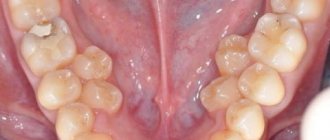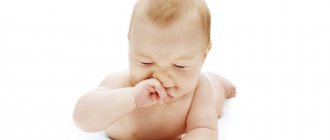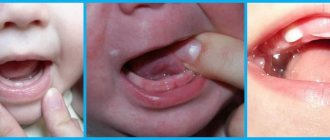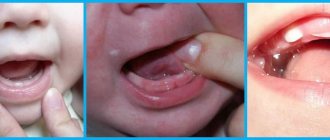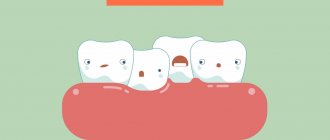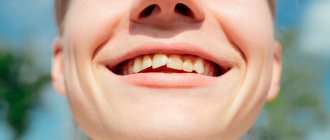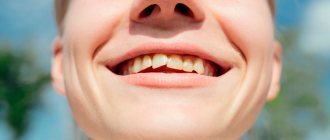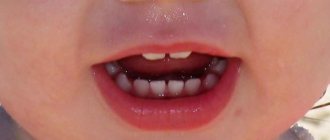At 4 months, primary teething often occurs. The child cannot independently communicate what exactly is bothering him, so strong crying appears. It gets worse at night. Some children tolerate this period calmly, while in others it manifests itself with negative symptoms, pain, and increased body temperature. If a child’s baby teeth begin to erupt before 4 months, it is necessary to look for deviations in health. Normally, they should appear at 4-6 months, so parents should monitor for symptoms.
Norm or pathology
Can teeth be cut at 3 months? The earliest age for the eruption of the first elements is considered to be three months of age. Dentists consider it normal for the first teeth to appear at 3 months of age. If the incisors appear earlier than the expected period, then the child should be shown to a therapist. The early appearance of elements on the surface of the gums may signal hormonal disruptions occurring in the body.
The appearance of baby teeth on the surface is accompanied by a number of distinctive symptoms:
- Pain in the gums. Because of this, the child puts fists and foreign objects into his mouth. At this moment, it is important for adults to ensure that there are no small toys or objects near the child that could get into the respiratory tract.
- Deterioration of the oral cavity. The gums swell and redden, becoming more sensitive to external irritants. In some cases, due to teething, the child may experience slight redness of the throat.
- Irritability and increased tearfulness of the baby. The symptom is associated with constant pain in the area of the eruption of the element. At this moment, children become more active and faster.
- Disorders of the digestive tract, manifested by loose stools, regurgitation, and rare bouts of vomiting.
- Temperature increase. The symptom is due to the fact that when teething, the newborn’s body is vulnerable to bacterial and viral pathogens.
The child is teething... How to help?
There is a popular saying: if a child is actively drooling, it means that his first teeth will soon appear. My personal experience does not confirm this wisdom. From two to three months everyone starts drooling, and teeth appear, as a rule, after six months.
The time for teeth to appear (with normal nutrition and care) depends mainly on heredity - of course, within certain limits. There is no reason to worry if everything is absolutely normal, the child is nine months old and has no teeth.
It simply doesn’t happen that teeth don’t grow at all. But no way to influence the timing of teething.
And there is no relationship between the state of the child’s health and the timing of teething. So there is no need to be nervous and worry in vain!
A deviation from the average teething norms of 6 months in one direction or another is considered normal!
Teeth cutting in the “wrong” sequence is not a sign of illness!
There are no medications that can affect the timing and sequence of teething!
However, there are a huge number of medications in the form of pleasant-tasting gels that are rubbed on a child’s gums, thus facilitating teething.
Such gels are divided into two groups - those containing a local anesthetic (usually benzocaine or lidocaine) and those not containing it.
Medical science strongly does not recommend the use of gels with benzocaine or lidocaine, as they provoke deadly complications, especially seizures and heart rhythm disturbances.
Carefully study the instructions for dental gels! If you find the word “benzocaine” or “lidocaine” in the product, do not buy it!
***
And now just some useful information.
The order of the teeth is recorded in the form of a dental formula. Individual teeth are designated by numbers. Each tooth has its own serial number, and the countdown starts from the center. The two rows of numbers in the dental formula correspond to the teeth on the upper and lower jaw.
| Age | Dental formula |
| 6–7 months | |
| 1 1 | |
| 8–9 months | 1 1 |
| 1 1 | |
| 10 months | 2 1 1 2 |
| 1 1 | |
| 12 months | 2 1 1 2 |
| 2 1 1 2 | |
| 12–15 months | 3 2 1 1 2 3 |
| 3 2 1 1 2 3 | |
| 18–20 months | 4 3 2 1 1 2 3 4 |
| 4 3 2 1 1 2 3 4 | |
| 20–30 months | 5 4 3 2 1 1 2 3 4 5 |
| 5 4 3 2 1 1 2 3 4 5 |
And one moment. Medical science believes that teething is very rarely accompanied by the development of a painful condition. But both practicing doctors (including the author) and the overwhelming majority of parents often observe how a seemingly healthy child suddenly, for no reason at all, deteriorates in mood, the temperature rises, and sometimes diarrhea begins. And after two or three days the tooth erupts, and everything goes away.
Symptoms of teething often include very severe itching of the gums, to satisfy which the baby pulls into the mouth everything that can be stuffed there.
It is not surprising that when a child is teething, the likelihood of swallowing a foreign body, getting a foreign body into the respiratory tract, and even the risk of intestinal infections increases significantly.
A safe, inexpensive, pleasant and effective method of assistance, highly recommended in the described situation, is the use of special teethers.
A teether is a wonderful device used, as the name suggests, during the teething stage. The teether safely relieves pain and itching of the gums, because you can gnaw and bite without any restrictions. The analgesic effect can be enhanced by pre-cooling the teether in the refrigerator or cold water.
You should know that teethers:
- made of rubber, silicone, latex, plastic, even wood;
- They often have a special shape designed to help with the eruption of certain teeth - lower anterior, upper anterior, lateral. But most often, teethers are universal, and this is written on the packaging;
- they often have bumps on the part that enters the mouth, allowing them to effectively massage the gums;
- As a rule, they are produced in a form resembling a ring, and this ring is convenient for a child to hold, chew, and examine.
Continuing the conversation about teeth, we note that there is no need to put off teaching your child to brush them until later. The first teeth have appeared - let's start brushing them! Moreover, the main attention should be paid not to care products (toothpastes, powders), but to the process itself, the need to brush your teeth with brushes. It is most convenient to begin this training in the bathroom - as a rule, the time when the child begins to sit in a large bathtub and the time when his first tooth appears coincides.
A special finger brush, as the name suggests, is placed on mom or dad’s finger and the exciting game of brushing your teeth begins. Your child will understand the rules of the game much faster if he sees you brushing your teeth.
The process of brushing teeth with a brush placed on the parents’ finger, as a rule, does not last long, since the child quickly develops a desire (reinforced by the opportunity) to do it on his own, especially if he constantly sees mom and dad doing this activity. This is where it comes time for your first personal brush. The first toothbrush should look something like the picture below. Its fundamental feature is a special limiter that regulates the depth of immersion in the mouth.
The first tooth, which most often appears around 6 months, also signals the baby’s readiness for complementary feeding. And during this fascinating process, you will definitely need a wonderful device with a name that is still unusual for our ears - a nibbler. Using a nibbler is very convenient to introduce your child to various vegetables and fruits. Moreover, the use of fruit juices, especially ready-made ones produced industrially, is not actively recommended by modern medical science.
Giving fruit juices to children is a tradition favored by the majority of the population, but needs to be re-evaluated because fruit juices contain excess calories and sugar and are low in nutritional value. As a result: the child willingly drinks sweet juice, instead of receiving truly healthy natural fruits and other foods containing carbohydrates, proteins, fats, fiber, calcium and other macro- and microelements.
So, the nibbler is a wonderful device for feeding a baby. It is a nylon mesh or silicone nozzle with numerous holes, attached to a base with a handle. Products used for complementary feeding are placed in the nibbler - usually vegetables, fruits, berries, and somewhat less often - bread, cookies, crackers, hard cheeses, etc. The child absorbs (softens) the contents of the nibbler and gets acquainted with new tastes without risk choke.
And a nibbler with chilled contents (for example, an apple straight from the refrigerator) is a wonderful way to relieve itchy gums during teething.
Also, with the help of a nibbler, you can introduce your child to a variety of tastes and foods early enough, and this, according to modern scientists, greatly reduces the risk of developing food allergies.
Just remember the main rule: thoroughly washing out food debris from the mesh and holes is the most important condition for the safe use of the nibbler.
All these very necessary items are included in the Tiny “First Tooth” set. But this is not just a set of individual products - it is a continuation of Dr. Komarovsky’s ideology to preserve the health of your child.
Each of the items is the result of careful selection, testing and scrupulous analysis of what the baby and his parents really need.
The contents of the set clearly correspond to the name - two teethers, finger toothbrushes (two sizes), the first individual toothbrush and a nibbler.
I think that once you start using all the items, you will appreciate this gift for mothers from Dr. Komarovsky.
author Komarovsky E.O. published 29/03/2018 17:57 updated 25/10/2020 — Lifestyle, Family
Scheme for cutting elements for children
Dentists have drawn up a specific scheme for the formation of primary occlusion in children. However, it is necessary to remember that each baby’s body is individual, and the teething dates established by doctors may deviate up or down by several months. Pathological signs of bite formation in babies include early eruption of incisors (up to 3 months of age) and the complete absence of elements in the oral cavity by 12 months.
The standard scheme for the formation of bite in children is as follows:
- 5–7 months – lower front incisors;
- 8–10 – upper incisors;
- 10–12 – upper lateral incisors;
- 11–13 – lower lateral incisors;
- 12–15 – upper and lower molars;
- 17–22 – canines (upper, then lower);
- 25–30 – upper and lower molars.
Pattern of tooth growth in infants
If a child is cutting teeth at 3 months, then these should be the front pair of incisors. If the side elements are shown first, then it is necessary to show the baby to the dentist. The symptoms corresponding to the process depend on the characteristics of the child himself. In some children, the elements appear completely unnoticed, in others they cause crying, fever, etc.
Alarming symptoms
Many signs of teething are harmless and go away on their own once the incisor comes to the surface. However, some signs may indicate the addition of bacterial or viral diseases against a background of weakened immunity.
Reviews of Dentokind for teething up to one year
Normal signs of the condition include:
- Profuse salivation. The symptom is observed in almost all children under three months. It does not require treatment for the child.
- Skin irritation near the chin. The symptom is caused by increased salivation during teething. It is enough to use an emollient cream every day at night to eliminate skin redness.
- The child's desire to breastfeed frequently. During feeding, the baby scratches its gums on the mother's nipple.
The list of alarming symptoms of teething includes:
- refusal to eat (more than 3-4 feedings);
- persistent diarrhea (may indicate an incipient intestinal infection);
- constant crying of the child.
Small bruises (hematomas) may appear in the eruption area. They dissolve quite quickly if you apply a compress to the problem area.
Signs of teething
You can understand that the first molar will soon come out by the following signs - the gums begin to swell and hurt greatly, which is accompanied by increased salivation. In this case, a similar picture can begin several months before the actual appearance of the teeth themselves. Sleep becomes restless, the child is capricious, due to severe discomfort, children refuse some meals, and an irresistible urge to put various objects in their mouth appears.
Once teething enters the active stage, you will notice a thin white line on the gum or a whitish protrusion. If you lightly tap the exposed teeth with a teaspoon, you will hear a slight clicking sound, some parents do this, but if you decide to do this test, do it very carefully.
How to correctly distinguish between symptoms
Some signs characteristic of the onset of the appearance of molars in children often overlap with the symptoms of infectious diseases. Therefore, if you have any doubts about this, it is better to seek advice from a specialist.
Pay attention to the temperature - it can rise to 38.5–39 degrees and stay for two days, this is normal. Paracetamol in small quantities is suitable for knocking it down, but if after this period the indicators do not decrease, you should not hesitate to go to the doctor.
Watery diarrhea also often occurs due to excessive salivation; normally, this repeats up to 2-3 times a day. If this period is exceeded and blood inclusions appear, there is already a reason to make an appointment with a specialist.
Regarding the runny nose, clear discharge that lasts 3-4 days does not cause concern; it is enough for parents to clear the sinuses of it in a timely manner.
If this period is exceeded, and the snot becomes whitish or greenish, do not hesitate to go to the doctor. The same applies to a cough, if it lasts more than two days and is accompanied by sputum, consultation is needed.
Factors affecting tooth growth
The speed of formation of a mixed bite depends on several circumstances:
- baby's genotype;
- performance of the thyroid gland;
- gender;
- severe infectious and viral diseases suffered in the past;
- duration of natural feeding;
- the presence of congenital diseases.
You also need to monitor the period of eruption of molars. They should come out to the surface of the gums only after the milk unit falls out. Otherwise, a mandatory visit to the dentist will be required. Early loss of milk elements is also undesirable, as this negatively affects the proportions of the baby’s jaw and his bite in the future.
Reasons for the atypical timing of the eruption of elements
Only a dentist can accurately determine the causes of abnormal teething in children. However, there are several common violations that lead to the problem:
- improper metabolism;
- lack of calcium in the body;
- disturbances in the functioning of the endocrine system;
- gastrointestinal pathologies;
- incorrect direction of the tooth axis.
Anomalies of the dentition can be associated not only with the timing of the appearance of elements, but also with the color, location, and size of the units in the row. If a child is already born with teeth, they are usually removed. Such situations are diagnosed quite rarely, and they indicate intrauterine disorders in the baby.
Ways to alleviate the condition
The formation of a bite is often accompanied by an increase in temperature. Therefore, parents should always have antipyretic drugs in their medicine cabinet (Panadol, Nurofen, Ibuklin). They not only reduce the temperature, but also relieve pain associated with tooth growth.
The love and attention of parents will allow the child to cope with the problem. The baby should be put to the breast and picked up as often as possible. Special teethers with gel will help satisfy your baby’s desire to scratch his teeth.
You need to choose small devices so that the child can comfortably hold it in his hand.
Pediatricians advise cooling teethers with cold water before giving them to a child. Instead of toys, you can give your baby chilled pieces of apple or carrot. At the same time, parents should carefully monitor that the baby does not bite off the product and does not choke on it. In parallel with this, local anesthetics can be used.
On the pharmacological market there are many drugs in the form of a gel that relieve pain during the appearance of teeth - Kalgel, Kamistad, Cholisal. Additionally, the gels have an anti-inflammatory effect, which also alleviates the child’s condition. The analgesic effect occurs 2-3 minutes after using the drug.
How to make your baby feel better when teething
We have already dealt with the question of whether teeth can erupt at the age of three months. But when this process begins, parents are faced with another dilemma - what to do to alleviate the child’s condition. In such a stressful situation, he needs physical and psycho-emotional contact - carry the baby in your arms, rock him, talk to him gently. This will help relieve nervousness. To eliminate other unwanted symptoms, the following methods are used:
- Gum massage. Do it with the tip of your finger, after washing your hands. To avoid injuring the child, you should also trim your nails. There are also silicone finger pads with bristles or pimples on sale. To determine the intensity of the massaging movements, you need to monitor the baby's reaction.
- Cold. Since regular teethers are not suitable for a 3-month-old baby, other alternative methods are used - cool the pacifier or apply a gauze cloth soaked in cold boiled water.
- Pharmacy products. If you notice that your baby's incisors are starting to come out, you should consult with your pediatrician about which gel or ointment to choose. Not all drugs are suitable for the youngest, but there is still a choice. For example, "Kamistad" or "Kalgel" are safe for three-month-old children.
- Antipyretic. Preparations based on paracetamol and ibuprofen help. In addition to normalizing body temperature, they relieve pain. Babies are often given candles, for example, Efferalgan.
You need to be careful to notice which method best helps your baby. During the period when teeth erupt, it also needs careful care. To avoid infection of the gums, you need to keep his pacifier clean and monitor breast hygiene. Saliva should be wiped away with clean napkins, without making any effort, so as not to irritate delicate skin. After this, you can apply baby cream with light massaging movements. Walking in the fresh air in places where there are not large crowds of people will be useful for the baby.


